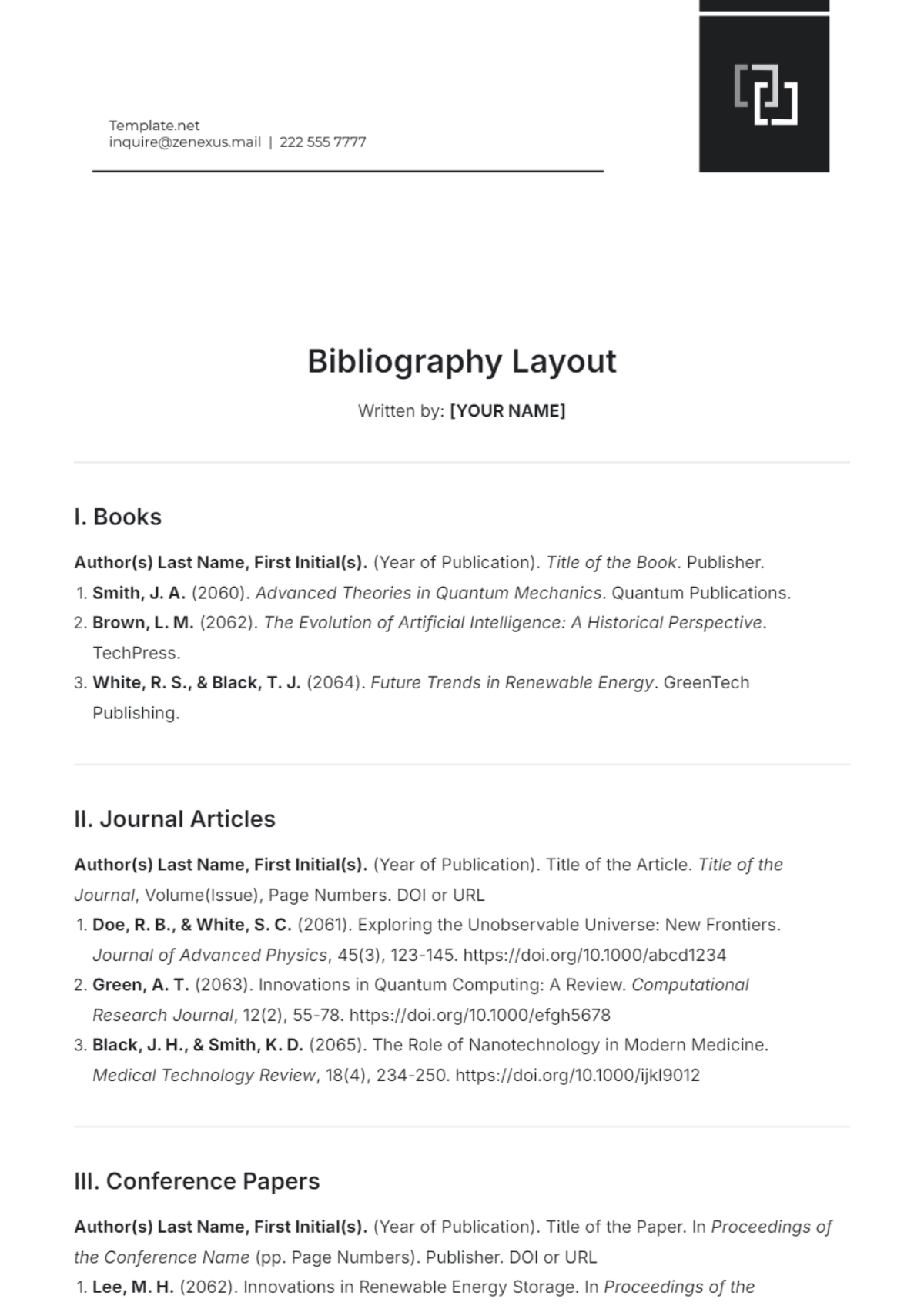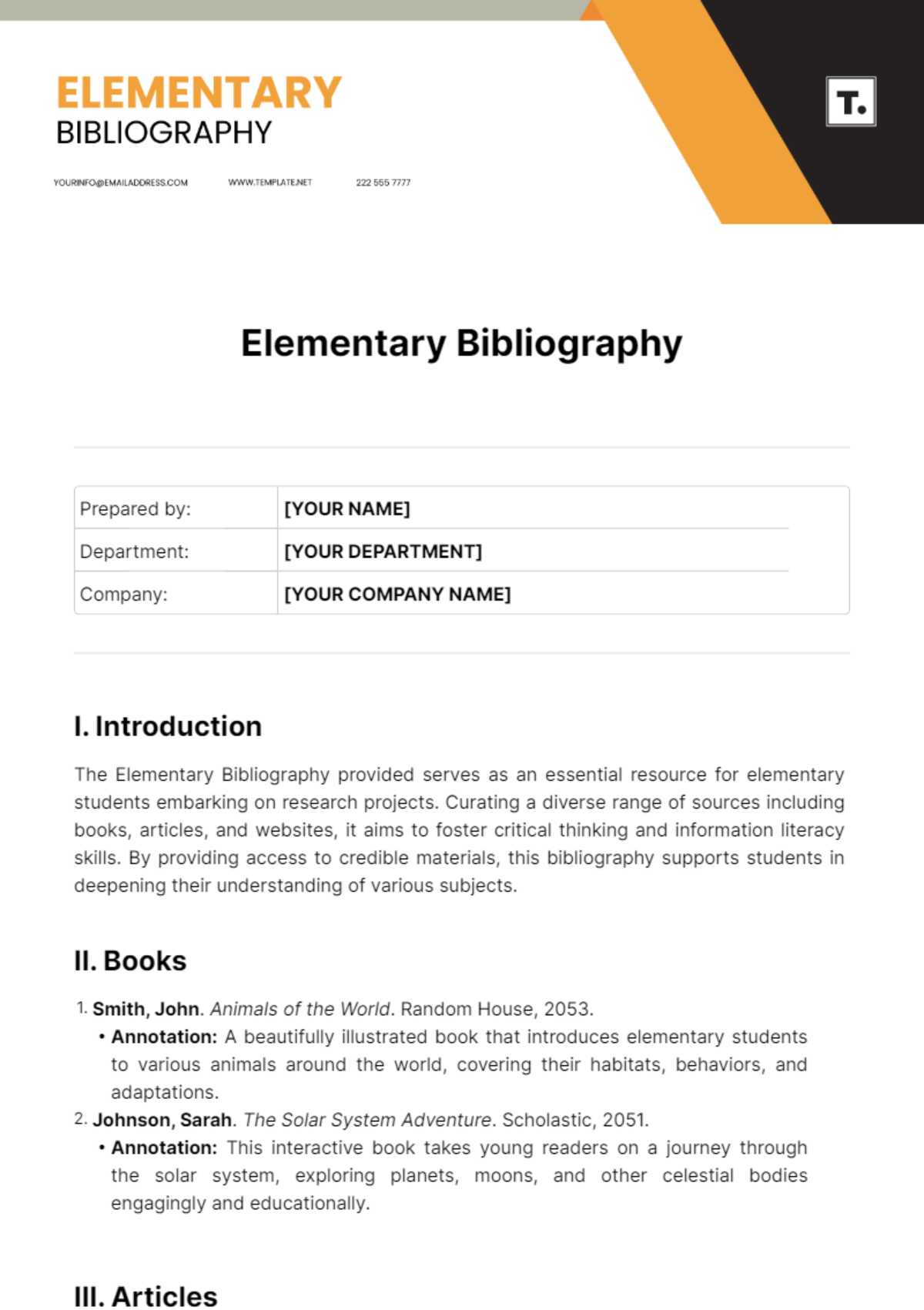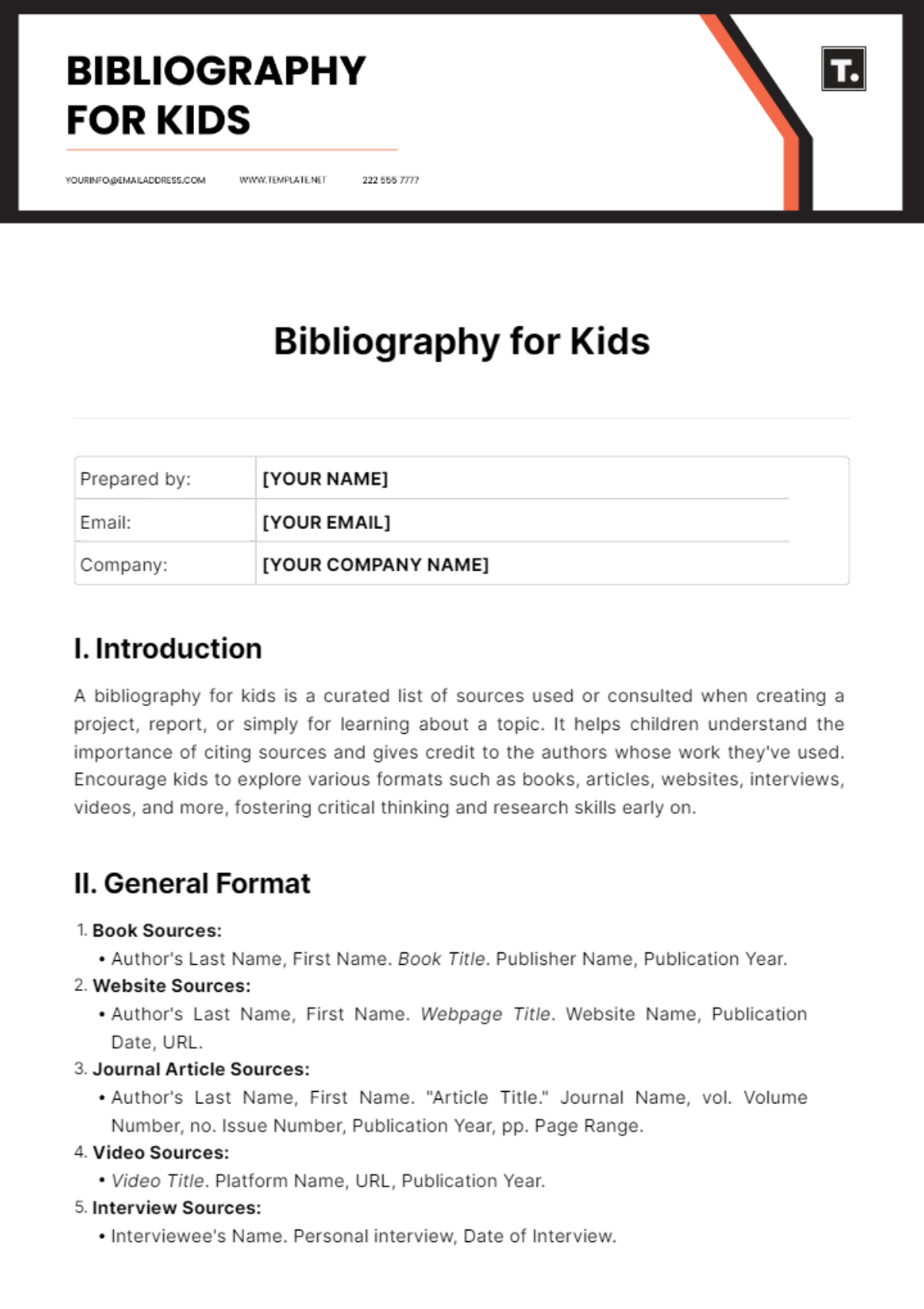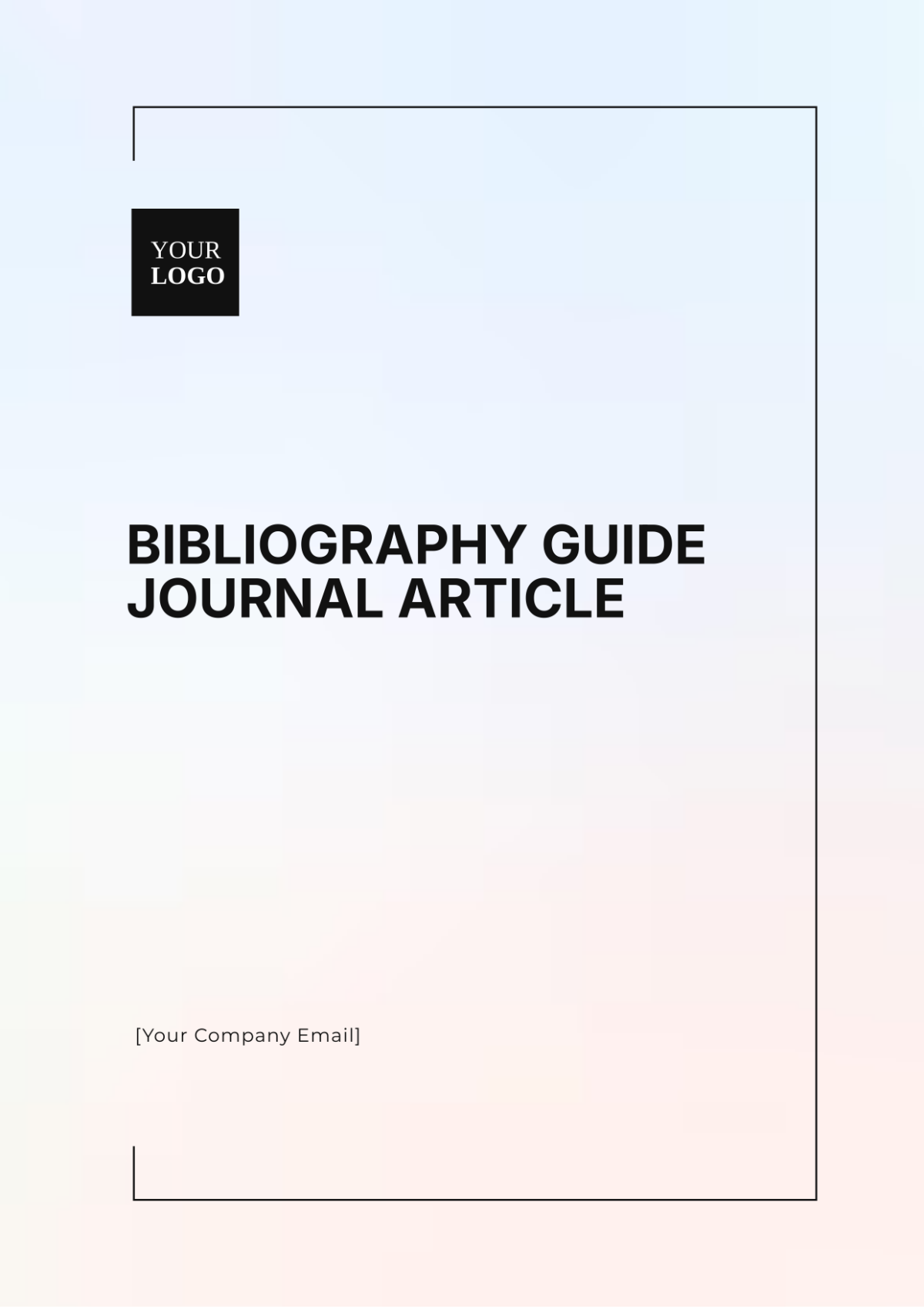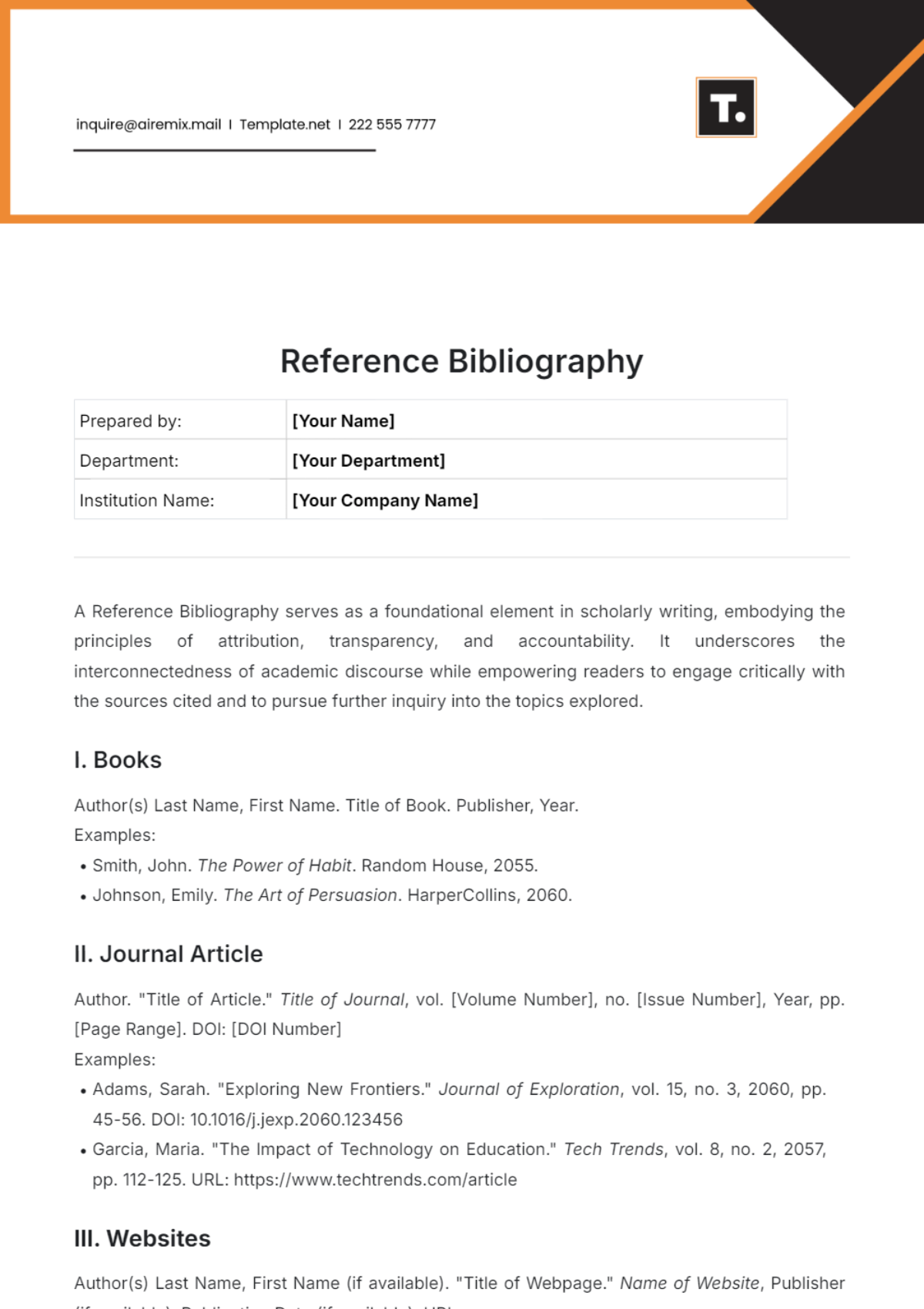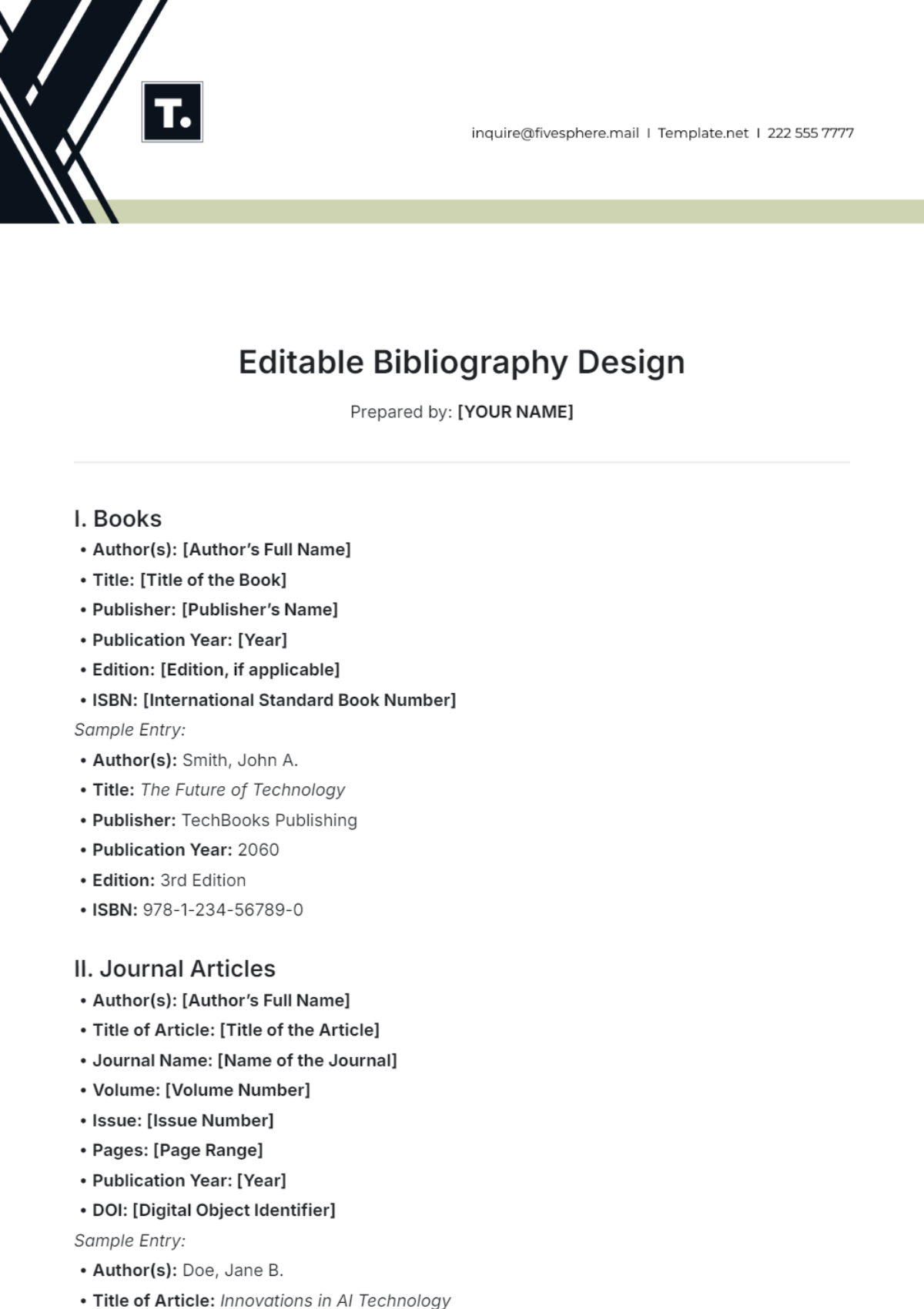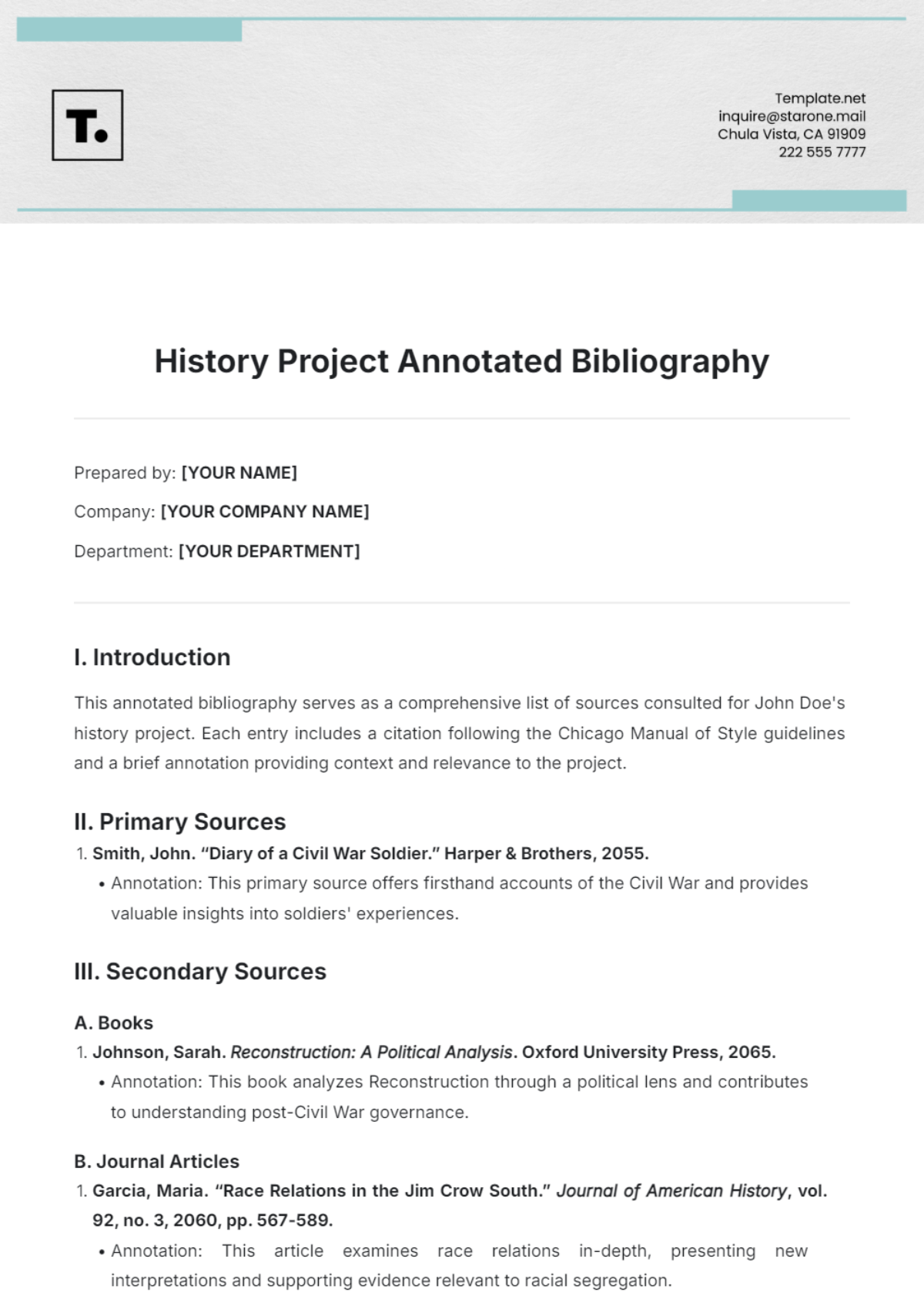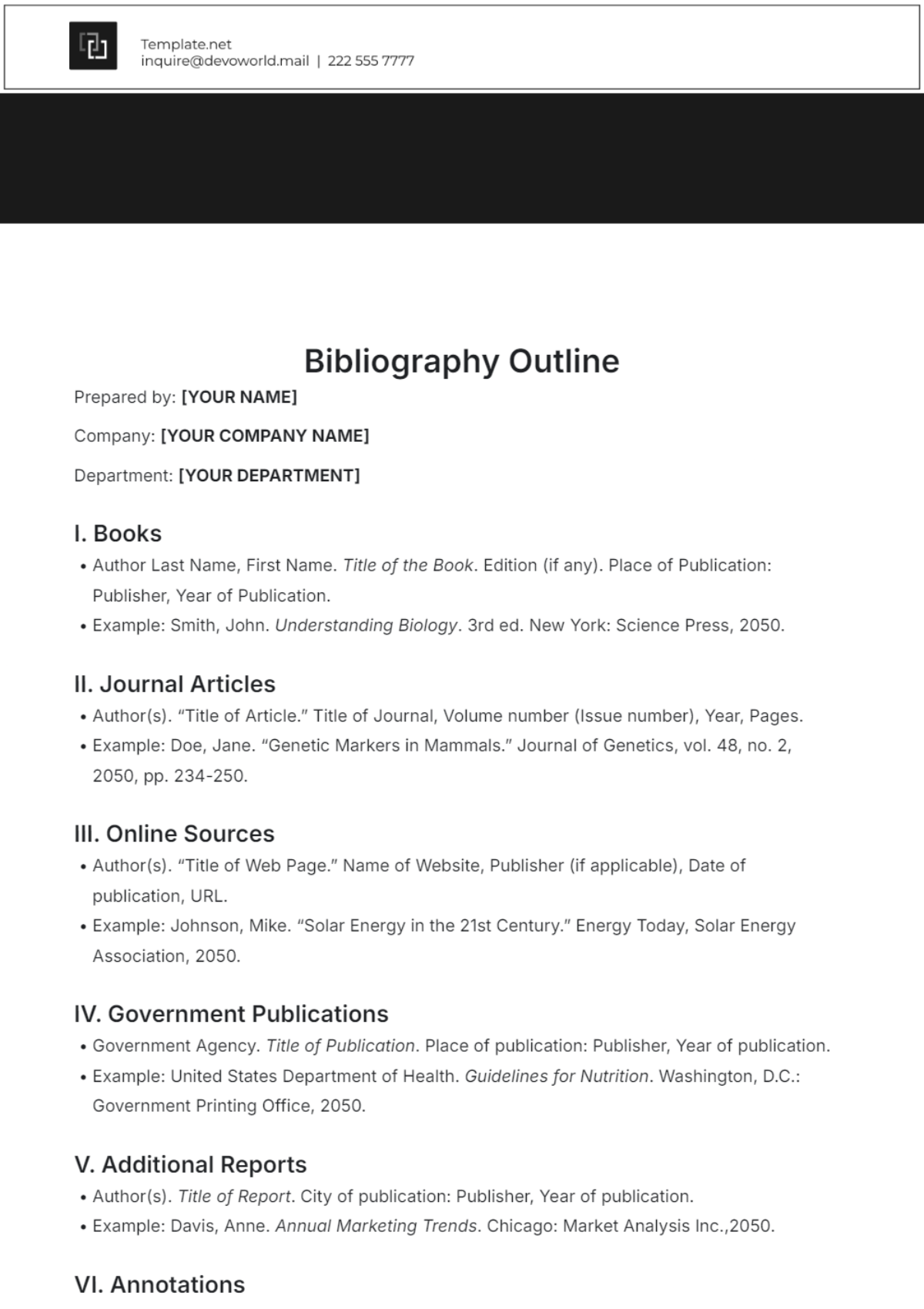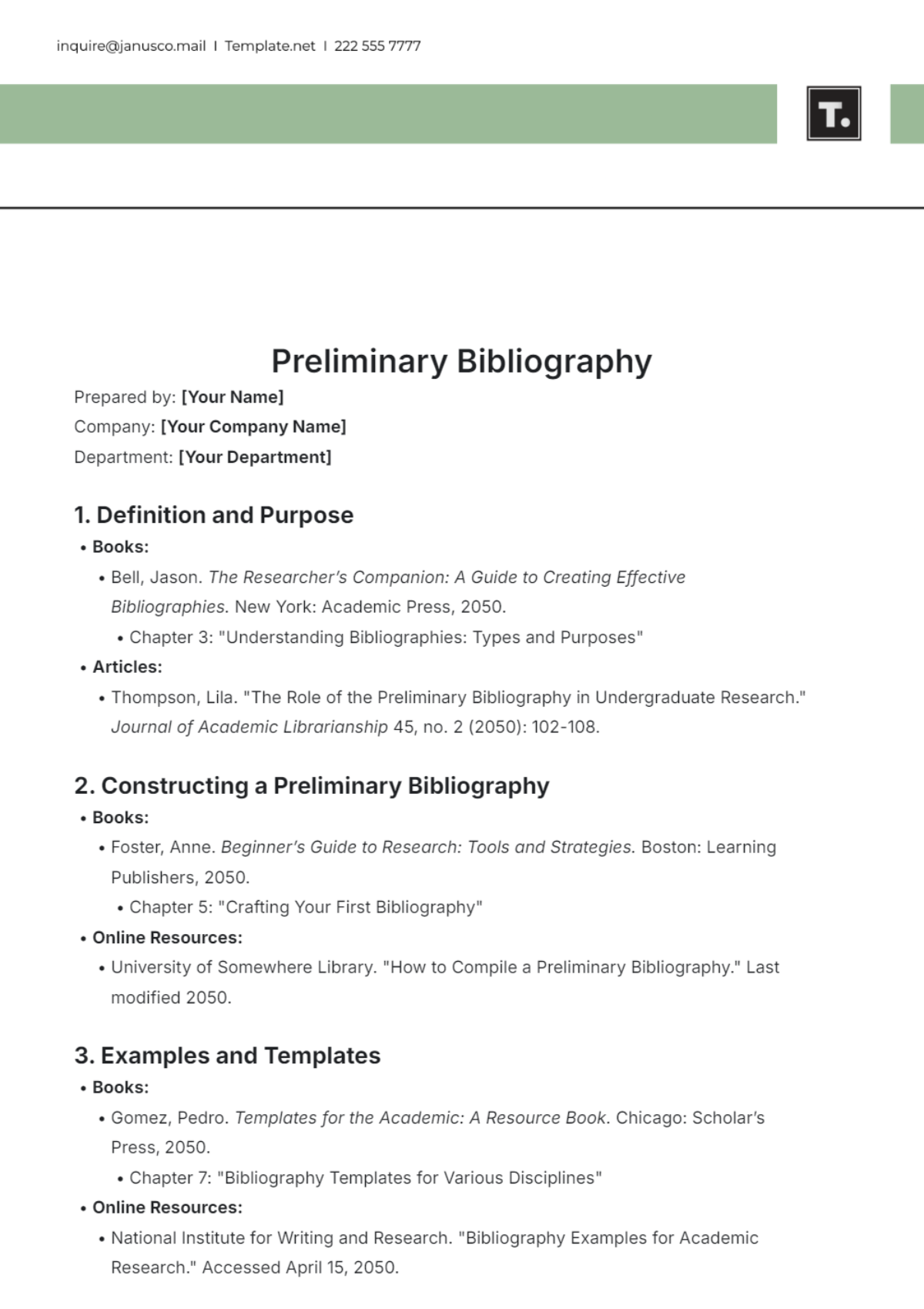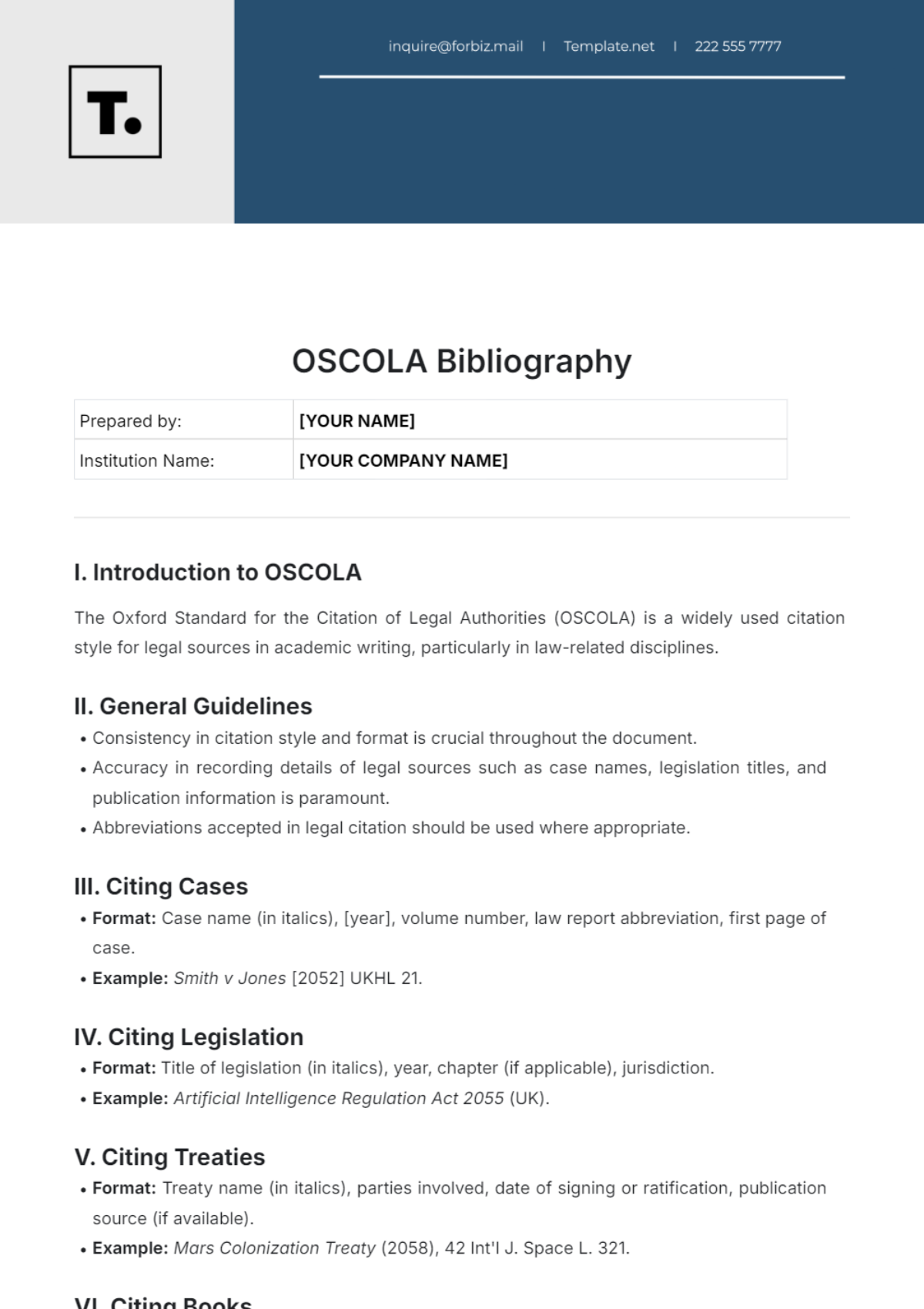APA Bibliography for Students
Prepared by: [YOUR NAME]
This bibliography is an essential part of any academic paper, providing a detailed list of all sources referenced in the work. Following the American Psychological Association (APA) style ensures that the bibliography is consistent, clear, and comprehensive. This guide outlines how to properly format and structure an APA-style bibliography.
I. Book References
Books are a common source of information in academic writing. When citing books, ensure to include the author(s), year of publication, title (in italics), and publisher.
Smith, J. A., & Doe, E. F. (2060). Advanced Concepts in Psychology (2nd ed.). Academic Press.
Williams, M. H. (2062). Understanding Artificial Intelligence in Education. Oxford University Press.
Johnson, P. L., & Carter, N. G. (2064). Cultural Dynamics in Globalized Education (3rd ed.). Routledge.
II. Journal Article References
Journal articles are critical for academic research. Include the author(s), year of publication, title of the article, title of the journal (in italics), volume number (in italics), issue number, and page numbers.
Johnson, L. M., & Wang, H. (2061). Cognitive development in early childhood: A longitudinal study. Journal of Developmental Psychology, 72(3), 145-160.
Garcia, R. E., & Patel, S. (2063). The influence of socioeconomic status on educational attainment. Educational Research Review, 58(2), 89-102.
Martinez, A. B., & Lee, Y. T. (2065). Virtual classrooms and student engagement: A comparative study. Journal of Online Learning, 45(4), 275-290.
III. Online Sources
Citing online sources requires the author(s), year of publication, title of the page or document, website name (if different from the author), and the URL.
Anderson, P. Q. (2062). The impact of digital learning on student performance. Education Today. Retrieved from http://www.educationtoday.com/digital-learning-2062
National Institute of Education. (2063). Educational reforms in the 21st century. NIE Publications. Retrieved from http://www.niepublications.gov/ed-reforms2063
Smithson, T. R. (2065). Emerging trends in virtual reality education. TechEd Online. Retrieved from http://www.techedonline.org/VRtrends2065
IV. Government Reports
Government reports are valuable resources for research and should be cited properly by including the authoring agency, year of publication, title (in italics), and report number if applicable.
U.S. Department of Education. (2063). Student engagement strategies in higher education (Report No. ED2063-01). Government Printing Office.
National Science Foundation. (2066). Advancing STEM education through innovation (NSF Report No. 2066-47). NSF Publishing.
World Health Organization. (2068). Global health trends and educational outcomes (WHO Report No. 2068-99). WHO Press.
V. Conference Papers
Conference papers are often cited in research. The citation should include the author(s), year, title of the paper, name of the conference (in italics), location, and page numbers if available.
Garcia, R. L. (2064). The role of artificial intelligence in education. In Proceedings of the International Conference on Educational Innovation (pp. 22-34). Tokyo, Japan.
Nguyen, A. M., & Chen, Y. S. (2067). Enhancing student collaboration in online environments. In Proceedings of the Global Conference on Digital Learning (pp. 55-68). Berlin, Germany.
Zhang, H. Q. (2069). Integrating augmented reality into science education. In Proceedings of the Annual Symposium on Educational Technology (pp. 101-112). New York, NY.
VI. Edited Book Chapters
When citing a chapter from an edited book, include the chapter author(s), year of publication, chapter title, editors of the book, title of the book (in italics), page numbers, and the publisher.
Mitchell, K. R. (2065). Educational psychology and teaching strategies. In L. T. Williams & M. A. Davis (Eds.), Modern Approaches to Teaching (pp. 112-130). Springer.
Turner, D. L., & Green, P. N. (2067). Innovations in distance learning. In R. F. Adams & J. K. Brown (Eds.), The Future of Education (pp. 54-72). Pearson Education.
Lawrence, S. E. (2070). The intersection of technology and pedagogy. In H. L. Jones & T. C. Smith (Eds.), Technology in the Classroom (pp. 90-108). Wiley.
VII. Theses and Dissertations
For theses and dissertations, include the author, year, title (in italics), type of document (Master’s thesis or Doctoral dissertation), and the institution.
Roberts, A. K. (2066). The influence of technology on classroom dynamics (Doctoral dissertation). Harvard University.
Davis, M. J. (2068). Teacher perceptions of inclusive education practices (Master’s thesis). University of California, Berkeley.
Patel, R. S. (2070). Exploring student motivation in blended learning environments (Doctoral dissertation). Stanford University.
VIII. Personal Communications
Personal communications, such as interviews, emails, or conversations, are not included in the bibliography but are cited in the text only.
(P. J. Adams, personal communication, March 5, 2067)
(L. M. Thompson, personal communication, June 12, 2068)
(R. C. Williams, personal communication, September 15, 2069)





